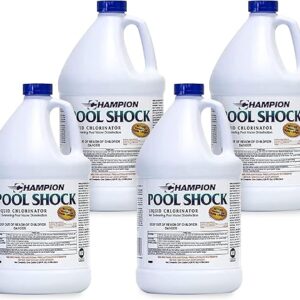3 Types of Swimming Pool Algae and How to Get Rid of Them

Swimming pool algae come in three different colors that are green, black, and yellow.
Green algae are the most common but not quit a task to get rid of since it floats freely on your water or hung loosely on pool walls and floor, unlike black or mustard(yellow) algae that come with strong roots making them hold firmly on the walls and floor of a swimming pool.
Green and black algae also have a strong coating that protects them from harsh chlorine and you may need to brush your swimming pool thoroughly using a steel brush to expose most of them for chlorine to them easily.
If you have a Saltwater pool, you have to put off your chlorine generator and add liquid chlorine manually just like a non-saltwater pool.
Requirements to Get Rid of Swimming Pool Algae
1. Reliable Test Kit
To get rid of swimming pool algae, you will need to reach very high free chlorine (FC) shock levels and maintain that shock level until all algae are gone. This means you will need a reliable pool chemical test kit that can measure higher FC levels.
One of the best pool chemical test kits we recommend is Taylor Technologies test Kit with FAS DPD that can measure a very high FC level of up to 50ppm.
2. Stainless Steel Pool Brush
To be able to remove all the rooted algae and remove all the coatings that protect black and yellow algae, you will need a very strong stainless steel brush with wire or stiff nylon bristles to knock off strong algae buildup.
3. Liquid Chlorine (Sodium Hypochlorite)
Liquid chlorine is the best chlorine for sanitizing and shocking a swimming pool when you have algae or ammonia breakout because it does not add other chemicals in your water ending up raising their levels.
Tablet chlorine is always high in Cyanuric acid (Cya) or chlorine stabilizer and using it will significantly raise your Cya levels. Powder chlorine or Calcium Hypochlorite is high in calcium and pH and will increase your Calcium Hardness (CH) and pH levels.
If you can get HASA Sanichlor liquid chlorine that is 12.5% chlorine it will take less time to clear algae. However, you can use Kem-Teks Chlorinating liquid with 10% available chlorine, or Pool Shock Liquid Chlorinator with 12.5% available chlorine.
4. Large Leaf Net or Hand Skimmer
Since you’ll be brushing your pool, it will be dirty and you may need to clean it before adding chlorine. You can use a large leaf net or hand skimmer to remove any debris you can spot in your pool.
How to Get Rid of Green, Black, and Yellow Swimming Pool Algae
1. Brush the Pool
Like we said earlier, green algae may not require heavy brushing of walls and floor of the pool and you can skip brushing if you see no obvious need to brush.
For black and Yellow algae, do thorough brushing. Use a stainless steel brush to knock off the strong algae protective coating so that most of it is exposed to chlorine.
2. Remove Debris and Vacuum the pool
Use a large leaf net or hand skimmer to remove any dirt or debris you can see. If you have a vacuum cleaner, you can use it to remove smaller debris before adding chlorine to your water.
If you have black or yellow algae and you brushed your pool, make sure your pool is free of loose algae before vacuuming and adding chlorine.
3. SLAM your Pool (Add Chlorine to Recommended Free Chlorine Shock Level and Maintain)
This is the most important part and you have to get it right to be able to get rid of all algae in your swimming pool: The FC shock level you will reach and maintain will depend on the level of Cyanuric acid (chlorine stabilizer) in your water.
The ideal range of Cyanuric acid (Cya) for a non-salt water pool is always 40ppm but can go higher up to 60ppm depending on the weather and FC levels. If your Cya level is 40ppm, the recommended shock level you will reach and maintain is 16ppm.
That means you will have to maintain the shock level of 16ppm by measuring FC level and adding more chlorine when FC shock level drops to 7ppm. Simply, you will be maintaining FC between 7ppm and 16ppm at Cya level of 40ppm until you kill all algae: View Chlorine/Cya chart by Trouble Free Pool to determine the correct shock level to maintain depending on your Cyanuric acid level in the water.
You’ll measure your FC level after every 4-6 hours and raise it back to the recommended shock level for your pool by adding chlorine. For example, don’t let FC drop below 7ppm which is the lowest your shock level can drop in Cya of 40ppm to conquer the algae.
If you have a Saltwater pool, your Cya levels should be between 70ppm and 80ppm. For Cya level of 70ppm, you’ll reach FC shock level of 28ppm, and for Cya of 80pp, you’ll reach FC shock level of 31ppm.
These high FC shock levels for Saltwater pools mean you can get rid of algae at first chlorine treatment, however, if the free FC level drops to 6ppm and you can still see algae, you will add more chlorine to attain the ideal FC shock level once again.
This process might take a couple of days or more to kill all swimming pool algae. In a day, you will test FC and add chlorine at least twice to hit the algae hard and kill it, so the process of getting rid of algae should begin early in the morning so that by the end of the day you shall have added chlorine at least twice.







